Martial Law had a huge impact on the Philippines, especially on Social Justice. In 1972, Martial Law was declared, changing the country’s history. It led to many arrests and detentions.
Over 50,000 people were arrested and detained from 1972 to 1975. This shows how the regime ignored human rights and Social Justice.
The Marcos regime lasted for 21 years, marked by graft and corruption. It cost the country 5–10 billion US dollars. This period hurt Social Justice, with Amnesty International finding at least 11,000 victims of killings, torture, and disappearances.
Martial Law’s effects on Social Justice in the Philippines were huge. The standard of living dropped, and poverty, inflation, unemployment, and debt rose. The Marcos family’s estate tax liability reached PHP 203 billion, showing their corruption and disregard for Social Justice.
Key Takeaways
- Martial Law was declared in the Philippines in 1972 and lasted for 14 years.
- Over 50,000 people were arrested and detained under Martial Law from 1972 to 1975.
- The Marcos regime was characterized by graft and corruption, resulting in a national loss of 5–10 billion US dollars.
- Amnesty International documented at least 11,000 victims of extrajudicial killings, torture, and enforced disappearances during the Martial Law period.
- The effects of Martial Law on Social Justice in the Philippines were far-reaching, with a significant decline in the standard of living and increased poverty, inflation, unemployment, and external debt.
- The Philippine History is marked by this period of Martial Law, which had a profound impact on Social Justice.
Understanding Martial Law in the Philippine Context
Martial Law in the Philippines means the military runs the government during emergencies. It affects Human Rights because some freedoms are suspended. The Constitution outlines when Martial Law can be declared, like during war or rebellion.
The use of Martial Law in the Philippines has been controversial. President Marcos’s regime in 1972 was known for human rights abuses. Over 11,000 people have been recognized for suffering during this time and are eligible for compensation.
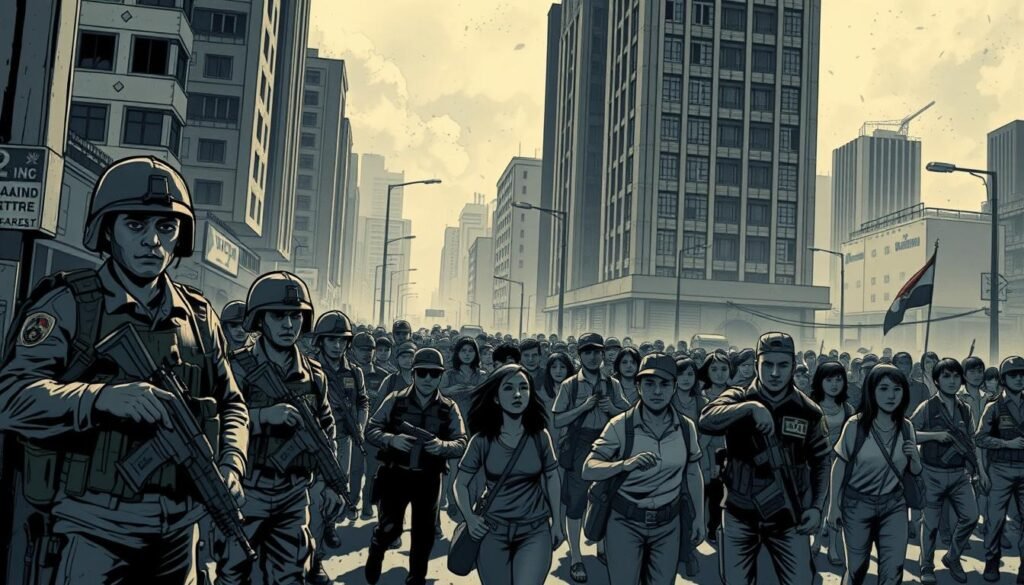
The history of Martial Law in the Philippines is complex. The Marcos regime’s rule in 1972 is a key example. Martial Law means some freedoms are lost, and the military takes charge. The Constitution sets rules for when Martial Law can be declared, like in times of war.
| Year | Event | Human Rights Implications |
|---|---|---|
| 1972 | Declaration of Martial Law | Suspension of certain rights and freedoms, widespread human rights abuses |
| 1973 | Referendum on Martial Law | |
| 1986 | EDSA People Power Revolution | Ouster of the Marcos regime, restoration of democratic institutions |
The Declaration of Martial Law and Initial Public Response
The Philippines declared Martial Law on September 23, 1972. This event lasted about 14 years and deeply affected the country’s social justice and social inequality. President Ferdinand Marcos’ declaration sparked widespread protests and opposition.
Before Martial Law, there were bombings and protests, like the First Quarter Storm. This event drew 50,000 to 100,000 people. The Philippine History of Martial Law is complex, with several declarations, including by Governor-General Ramon Blanco in 1896 and President José P. Laurel in 1944.
The public’s first reaction to Martial Law was shock and resistance. Many Filipinos were worried about its impact on democracy. The period saw human rights abuses, like killings, torture, and disappearances. Martial Law worsened social inequality and undermined the rule of law.
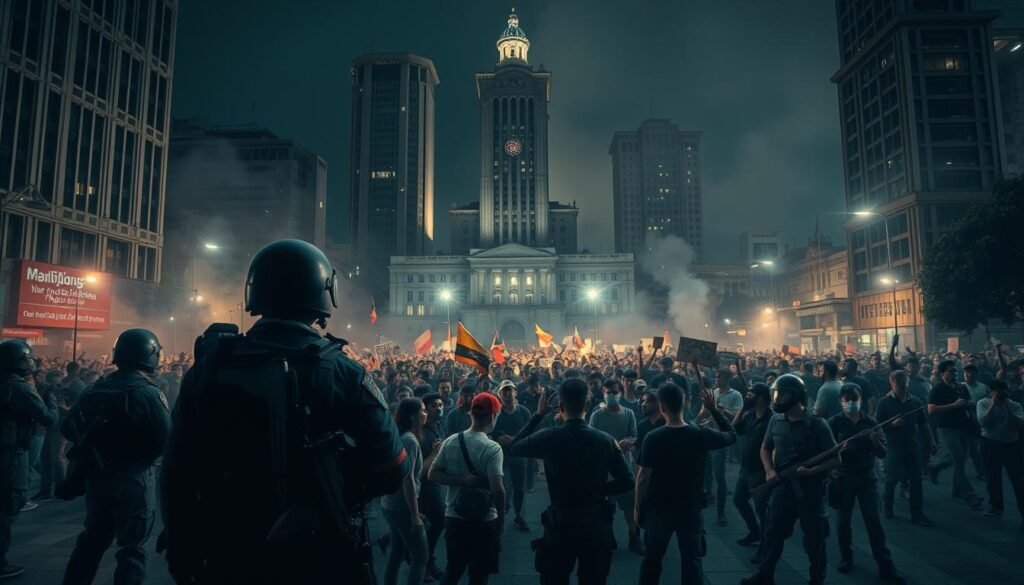
In conclusion, Martial Law in the Philippines was a key moment in history. It had lasting effects on social justice and social inequality. Understanding Philippine History and Martial Law is vital for a fair and just society.
Fundamental Changes to Social Justice Systems
The declaration of martial law deeply affected the Philippines’ social justice systems. It brought about big changes in the judicial system, civil rights, and law enforcement. These changes made it harder for people to seek justice and created a culture of fear.
Key changes included the creation of military courts to try civilians. There were also limits on habeas corpus, making it tough to challenge detention. The judicial system gave the military more power, leading to less rule of law and more human rights abuses.
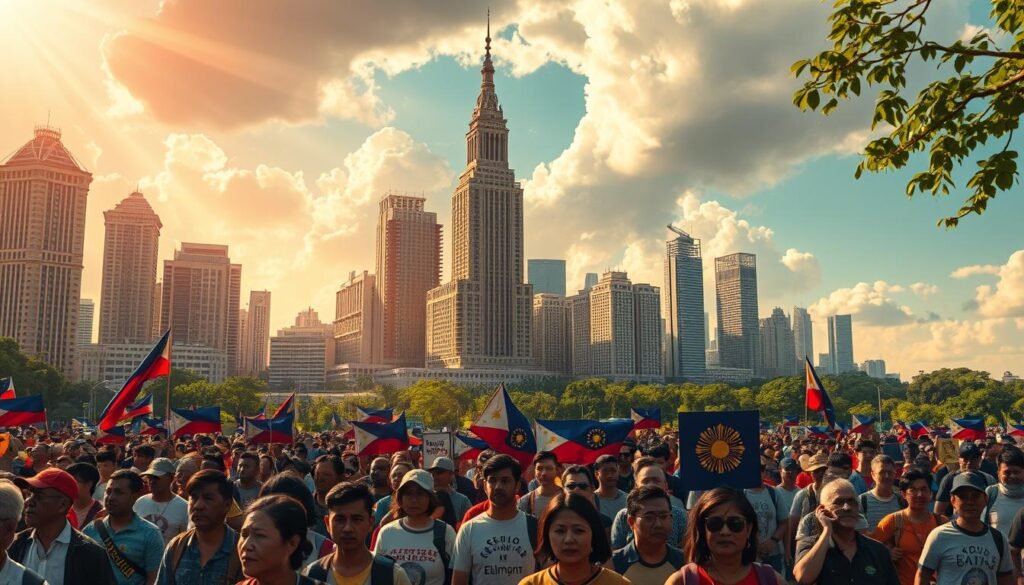
The civil rights were severely restricted. There were limits on freedom of speech, assembly, and the press. This made it hard for people and groups to speak out against the government. It also led to a climate of fear and repression.
The changes in law enforcement, with the military and police playing bigger roles, also impacted social justice in the Philippines.
Some of the key aspects of these changes include:
- Establishment of military courts to try civilians
- Restriction of habeas corpus to limit challenges to detention
- Modification of the judicial system to give the military more control
- Restrictions on civil rights, including freedom of speech and assembly
Economic Implications and Wealth Distribution
The declaration of martial law has big Economic Implications for a country’s economy. It leads to less economic growth and more poverty and Social Inequality. Recent data shows global income inequality is getting worse, like in the early 20th century.
The top 10% of people have seen their income share go up a lot. But those in the bottom 50% have lost more in income share.
The Wealth Distribution in a country can change due to taxes and globalization. The average top income tax rate for OECD members has dropped from 62% in 1981 to 35% in 2015. This has made the Social Inequality gap wider.
The table below shows how income shares have changed:
| Year | Top 10% Income Share | Bottom 50% Income Share |
|---|---|---|
| 1980 | 30% | 20% |
| 2010 | 40% | 15% |
| 2020 | 45% | 10% |
The Economic Implications of martial law can last a long time. It’s key to tackle the causes of Social Inequality and aim for a fairer society.
Human Rights During the Martial Law Era
The Philippines’ Martial Law led to a big drop in human rights. Many cases of torture, disappearances, and killings were reported. The international community saw these wrongs and spoke out against the Philippine government.
Some key human rights issues include:
- 3,257 known extrajudicial killings
- 35,000 documented cases of torture
- 737 individuals reported as ‘disappeared’
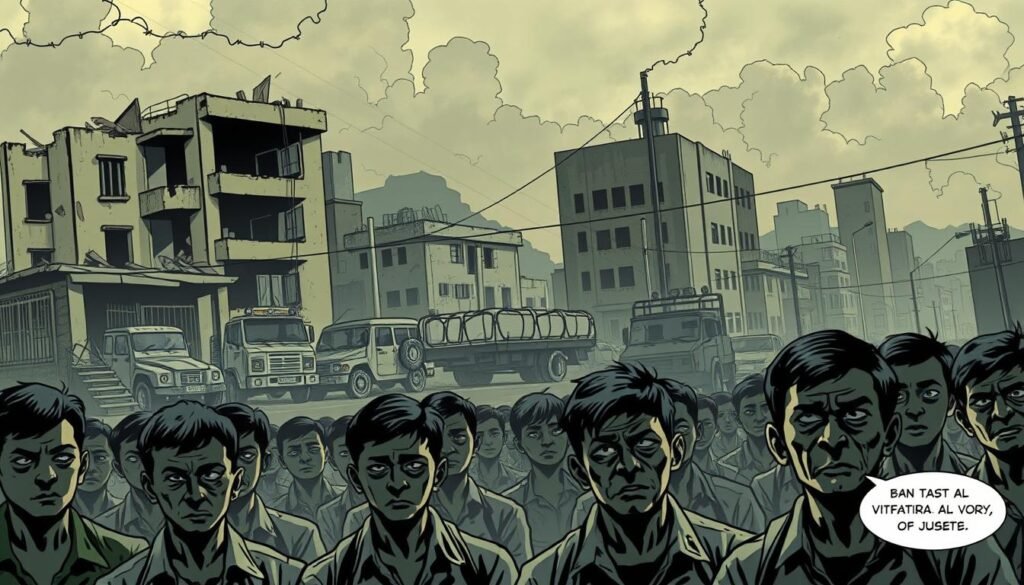
government and military didn’t face consequences. This created a culture of no accountability.
Resistance movements formed to fight the government and highlight Martial Law’s effects. They were key in showing the abuses and pushing for justice.
Impact on Social Justice Institutions
The declaration of Martial Law had a big impact on Social Justice institutions in the Philippines. The judiciary, media, and civil society groups were all hit hard. They faced restrictions and lost their independence.
The military courts and censorship of journalists were key ways Martial Law limited these groups. This made it hard for them to fight for Social Justice.
The effects of Martial Law on Institutions were wide-ranging. Many civil society groups had to hide, and their members were hunted. The media was also censored, with many outlets closed.
This made it tough for the media to report on human rights and Social Justice issues.
The impact of Martial Law on Social Justice institutions can be seen in several ways:
- Restrictions on judicial independence
- Establishment of military courts
- Censorship of journalists and media outlets
- Persecution of civil society organizations and their members
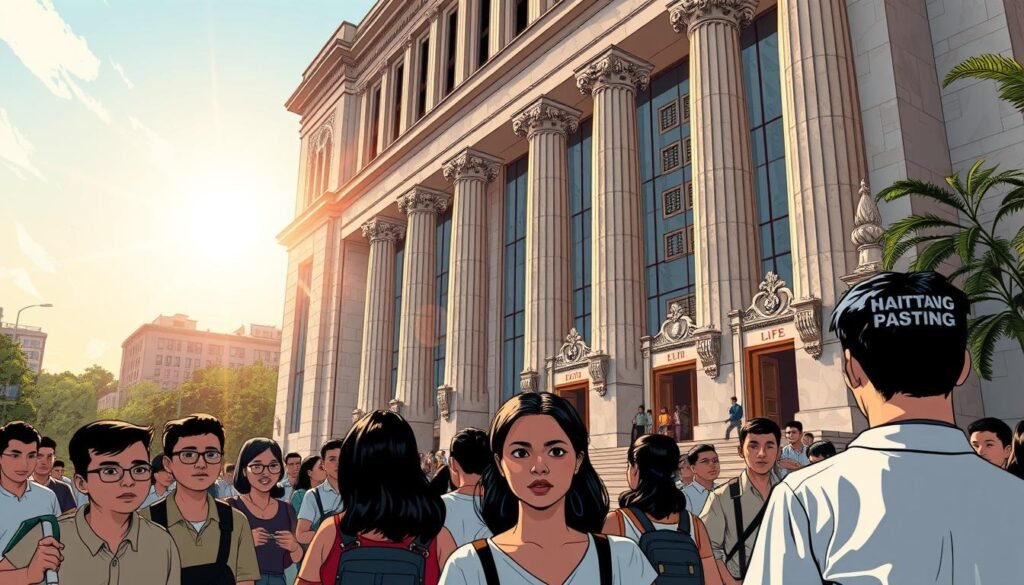
In conclusion, Martial Law had a big impact on Social Justice institutions. It affected the judiciary, media, and civil society groups a lot. Understanding these effects is key to promoting Social Justice and protecting human rights in the Philippines.
Media Freedom and Information Control
The media is key in a democratic society. Media freedom lets citizens get accurate, unbiased info. But, martial law can lead to censorship, limiting media’s ability to report.
The underground press helps journalists and activists bypass censorship. They use alternative media like online news and social media. These aren’t controlled by the government like traditional media.
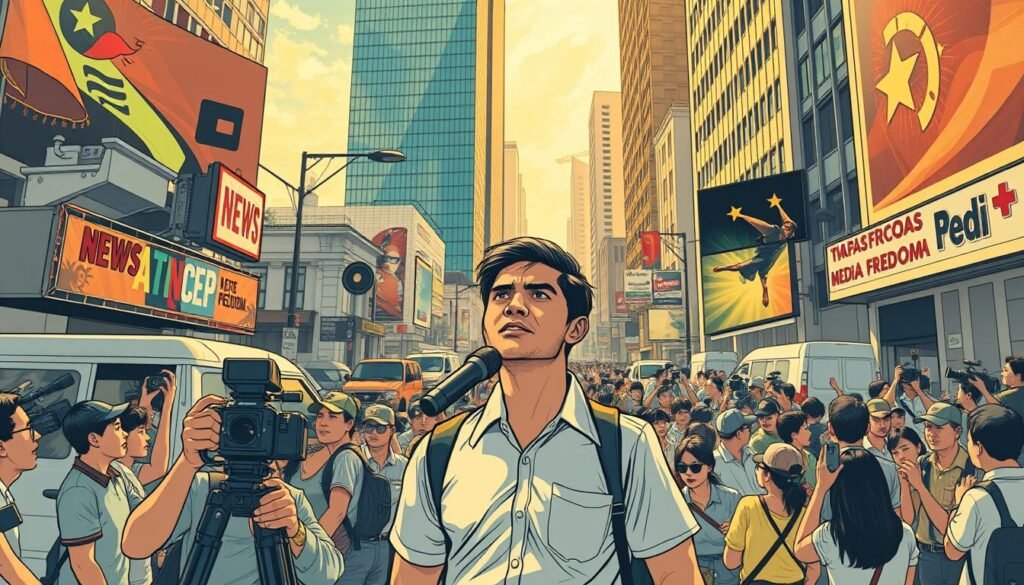
In countries like Hungary, nearly 80 percent of media is owned by government allies. This shows how Viktor Orbán’s government has consolidated media. In Venezuela, media repression has grown since January, when the opposition named Juan Guaidó as acting president.
It’s vital to protect media freedom. We must ensure journalists and media can work freely. Legal protections and social norms that value a free media are key.
Educational System Changes and Academic Freedom
Martial Law had a big impact on the Educational System in the Philippines. It limited Academic Freedom, with strict rules on what could be taught. A report by the International Conference on Academic Freedom and University stressed the importance of universities in promoting justice and knowledge.
The effects of Martial Law on education were huge. Academic freedom was greatly restricted. This made it hard for students and teachers to think critically and discuss ideas freely. Many universities found it tough to stay independent and free.
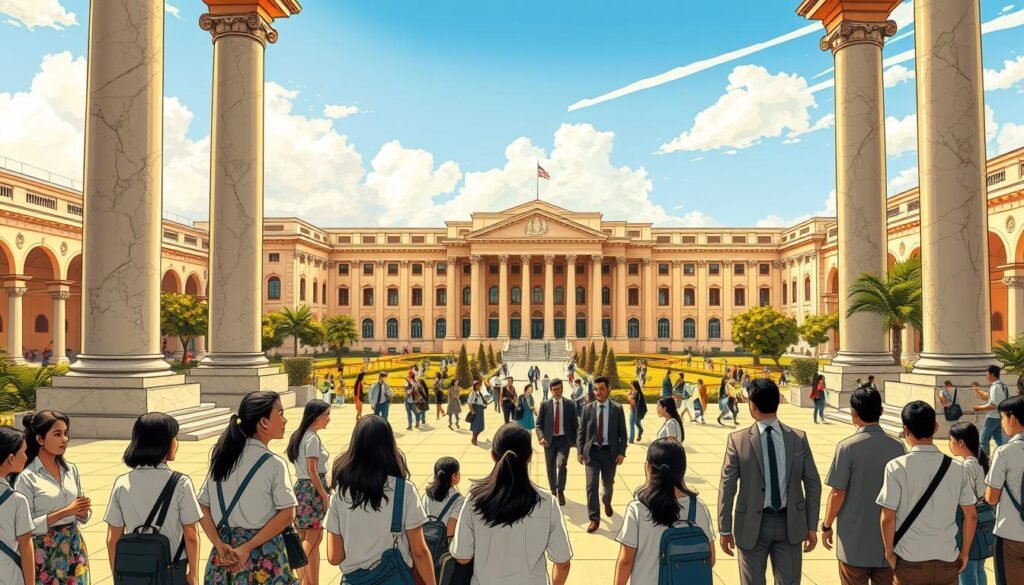
Today, worries about losing Academic Freedom in universities are growing. A survey by the American Association of University Professors showed 58% of teachers feel their freedom is threatened by politics. This shows why universities must protect Academic Freedom, allowing students and teachers to explore ideas freely.
The changes from Martial Law still affect the Philippines’ Academic Freedom today. It’s crucial to support and defend Academic Freedom. This ensures universities can continue to advance knowledge and fight for justice.
Religious Institutions and Social Justice Advocacy
Religious institutions have long been key players in social justice. They tackle issues like poverty, inequality, and human rights. In the context of church-state relations, they often lead social justice movements. They use their moral voice to shape policy and bring about change.
The Catholic Church’s fight against martial law in the Philippines is a prime example. Their stance was rooted in their commitment to religious institutions and human dignity. Sources like historical accounts show the Church’s advocacy has shaped policy and promoted human rights.
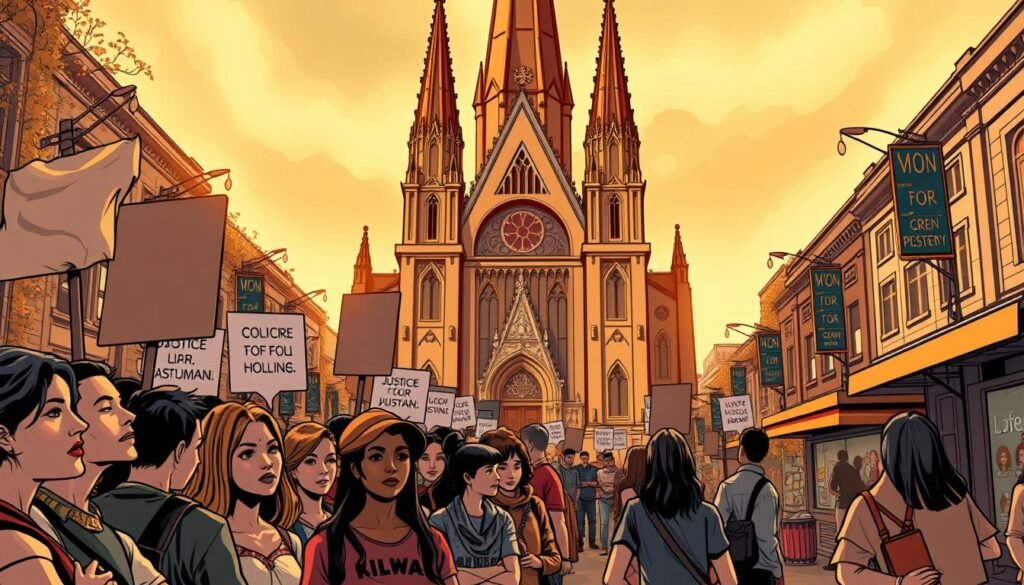
The bond between church-state relations and social justice is intricate. Some say religious groups should stay out of politics. Yet, others see them as crucial for social justice and human rights advocacy. The essence of effective advocacy lies in understanding complex issues and a dedication to positive change.
Labor Rights and Worker Movements
Labor rights and worker movements face big challenges under Martial Law in many countries. Data shows that 81% of countries don’t let workers bargain together. Also, 65% block certain workers from labor laws. This makes it hard for workers to fight for their rights.
The link between labor rights and civil rights is strong. When one is restricted, the other suffers too. For example, Martial Law can silence worker movements. This stops workers from improving their work conditions.
Here are some examples of how Martial Law affects Labor Rights and Worker Movements:
- Over 12,000 garment factory workers in Bangladesh were fired for protesting over wages in December 2018 and January 2019.
- Since 2016, Thammakaset Company Limited in Thailand filed more than 13 civil and criminal lawsuits against former workers and their supporters.
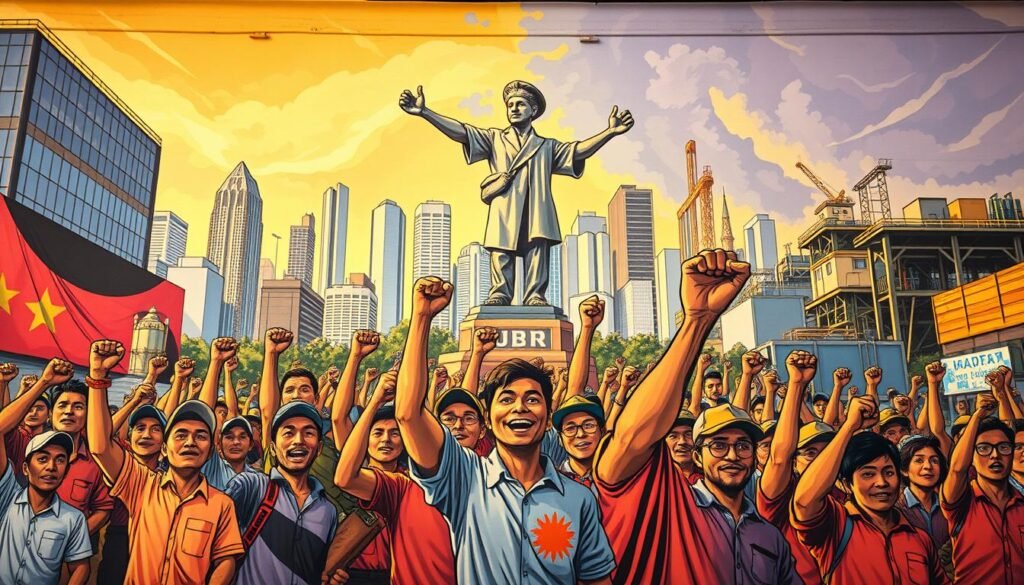
In summary, limiting Labor Rights and silencing Worker Movements under Martial Law hurts workers and the economy. We must support Labor Rights and worker movements. This way, workers can speak up and fight for their rights.
Indigenous Peoples and Minority Rights
Martial law has a big impact on Indigenous Peoples and minority rights. There are over 5,000 different Indigenous Peoples worldwide, with 476 million people. It’s crucial to tackle the challenges they face. Indigenous Peoples and minority rights are often ignored, leading to more poverty, land loss, and displacement.
Land disputes are a big problem for Indigenous Peoples. Many communities are pushed out by development projects. Cultural preservation is also a big worry, as they struggle to keep their culture with government policies and outside influences. The numbers are scary, with Indigenous Peoples facing more poverty, illiteracy, and joblessness than others.
Some key statistics highlighting the challenges faced by Indigenous Peoples include:
- Indigenous Peoples make up approximately 6 percent of the global population
- Indigenous Peoples account for about 19 percent of the extreme poor
- Life expectancy of Indigenous Peoples is up to 20 years lower than that of non-Indigenous Peoples worldwide
We must tackle these issues and support the rights of Indigenous Peoples and minority groups. This can be done by creating inclusive policies and practices. These should respect and recognize the cultural identity and rights of these communities.
Women’s Rights and Gender Equality
Martial law has a big impact on women’s rights and gender equality. The UN Women Executive Director Phumzile Mlambo-Ngcuka says gender equality is key for social justice and development. During martial law, women faced many restrictions and gender-based violence.
Here are some important facts about women’s situation:
- Women make up less than 24% of the world’s parliamentarians.
- On average, women are paid 24% less than men for the same work.
- Nearly two thirds of the world’s 781 million illiterate adults are women.
The restrictions on women’s rights and the rise in gender-based violence during martial law are big concerns. Gender equality is crucial for social justice and sustainable development. The impact of martial law on women’s rights and gender equality is a major issue that needs to be addressed.
Long-term Effects on Philippine Social Justice
Martial law has deeply affected Philippine social justice. It has changed the country’s laws and society. The legislative legacy of martial law is seen in laws like free tuition and national health insurance for all.
The martial law era has also changed society and economy. These changes were due to government policies and civil society actions. The middle class has grown, and people are more aware of social justice issues.
The following table highlights some of the key statistics related to social justice in the Philippines:
| Indicator | Value |
|---|---|
| Poverty incidence | 18.1% |
| Unemployment rate | 6.6% |
| Gini coefficient | 0.423 |
While some social justice indicators have improved, there’s more to do. The legislative legacy of martial law still influences social justice in the Philippines. It’s crucial to understand these long-term effects on societal changes and social justice.
Conclusion
Martial Law has had a big impact on Social Justice in the Philippines. It has left a lasting mark on the country’s history. Social Justice efforts can boost the economy, studies show.
In the Philippines, about 25% of people live in poverty. This shows the need for Social Justice actions. Martial Law teaches us the value of human rights and Social Justice.
The Philippines is working to improve its future. It’s important to focus on Social Justice and deal with Martial Law’s effects. This way, the country can become more equal and free, shaping a better history.
FAQ
What is martial law and how does it affect social justice in the Philippines?
Martial law means a country is run by the military. In the Philippines, it has hurt social justice. It limits civil rights, leads to human rights abuses, and slows down the economy.
What are the historical precedents of martial law in the Philippines?
The Philippines has seen authoritarian rule before. Ferdinand Marcos declared martial law in 1972. This led to military rule and human rights abuses.
How does martial law affect the judicial system in the Philippines?
Martial law changes the judicial system in the Philippines. It sets up military courts and limits habeas corpus. This hurts judicial independence and increases human rights abuses.
What are the economic implications of martial law in the Philippines?
Martial law hurts the economy. It leads to slower growth, more poverty, and wealth concentration. This widens the wealth gap and reduces social mobility.
How does martial law affect human rights in the Philippines?
Martial law badly affects human rights. There are cases of torture, disappearances, and killings. It also limits freedom of speech, assembly, and the press.
What is the role of the media during martial law in the Philippines?
The media faces censorship and repression under martial law. The government limits press freedom and censors media. This leads to an underground press movement.
How does martial law affect educational institutions and academic freedom in the Philippines?
Martial law restricts education and academic freedom. It limits freedom of thought and imposes censorship. This harms critical thinking and intellectual freedom.
What is the role of religious institutions in social justice advocacy during martial law in the Philippines?
Religious institutions, like the Catholic Church, are key in advocating for social justice. They speak out against abuses and push for justice.
How does martial law affect labor rights and worker movements in the Philippines?
Martial law harms labor rights and worker movements. It restricts collective bargaining and represses unions. This leads to fewer worker rights and more exploitation.
What is the impact of martial law on indigenous peoples and minority rights in the Philippines?
Martial law hurts indigenous peoples and minority rights. The military and government often displace communities and restrict cultural practices. This harms cultural preservation and increases abuses.
How does martial law affect women’s rights and gender equality in the Philippines?
Martial law restricts women’s rights and gender equality. It limits women’s freedoms and perpetuates violence. This harms equality and boosts feminist activism.
What are the long-term effects of martial law on Philippine social justice?
Martial law’s long-term effects on social justice are significant. It leaves a legacy that impacts justice today. It also leads to less inequality and more activism.
Source Links
- Five things to know about Martial Law in the Philippines
- On Martial Law at 50: Fact-Checking the Marcos Story, Countering the EDSA History | Heinrich Böll Foundation | Southeast Asia
- Philippines – Martial Law, Marcos, Dictatorship | Britannica
- The Methods of Regime Survival
- Martial Law Revisionism and the Fight for History — UP College of Law
- Martial Law and Its Aftermaths: A Personal History
- Martial law in the Philippines
- Martial Law Explained
- Social and Racial Justice as Fundamental Goals for the Field of Human Development
- 15 Ways to Advance Social Justice in your Community
- Rising inequality: A major issue of our time
- Causes and Consequences of Income Inequality – An Overview
- Human rights abuses of the Marcos dictatorship
- Jurisprudence on Martial Law Atrocities and Stories — UP College of Law
- Philippines: Martial Law Threatens Escalation of Abuses
- The Interplay of Social Change, Social Impact, and Social Justice – The Social Leadership Coach
- AI and Social Justice: Navigating the Impact of Artificial Intelligence on Society’s Equity and Inclusion — Our Future Is Science
- Media Freedom: A Downward Spiral
- Globalising Social Justice, Democracy and Press Freedom – International Federation of Journalists Statement to the World Economic Forum (New York) and the Social Forum (Porto Alegre) January/February 2002 / IFJ
- Freedom of expression in times of conflict – Freedom of Expression – www.coe.int
- Academic Freedom as a Professional, Constitutional, and Human Right
- Evaluating Pressures on Academic Freedom | Published in Houston Law Review
- Bridging Faith and Social Justice Across Generations (SSIR)
- The Church’s Imperative: Advocating for Equity and Justice through Political Engagement – NAYA
- Faith-Based Social Justice: Affordable Housing and Interfaith Work
- Rising restrictions on labour rights threaten the heart of social justice
- Workers’ rights – National Action Plans on Business and Human Rights
- InfoStories: Laying the foundations of social justice
- Indigenous peoples rights are human rights.
- Indigenous Peoples
- Minorities | United Nations
- Gender justice and women’s rights | Oxfam International
- If you defend human rights, you defend women’s’ rights.
- Change without Transformation: Social Policy Reforms in the Philippines under Duterte
- Challenges and Prospects for Social Justice within Government’s economic agenda
- Social Justice: A Path Towards a Fair and Equal Society
- Social Justice -> Local Government: Not-A-Conclusion – ELGL

